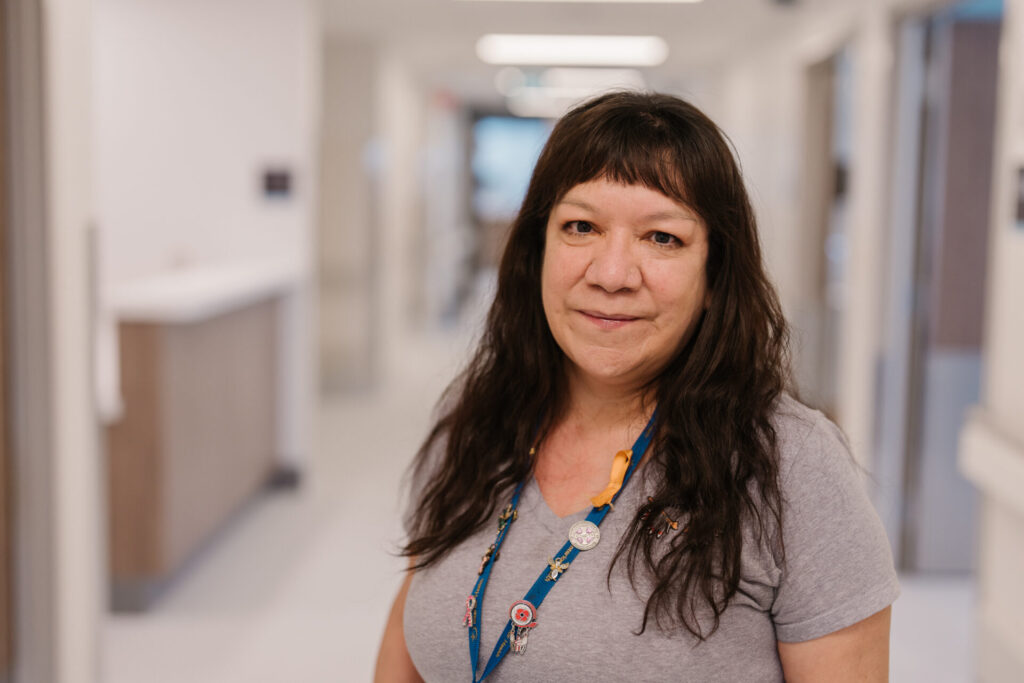Aboriginal Patient Navigator
Meet Deb Donald, Aboriginal Patient Navigator (APN) at Royal Inland Hospital (RIH). Deb is from the Simpcw First Nation and brings with her an abundance of cultural awareness and genuine compassion for her patients and their families. Deb started as an APN at RIH September 15th, 2008, and has since offered 15 years of incredible service. Through this spotlight, you will dive deep into Deb’s steadfast commitment to supporting Indigenous patients and families in the Thompson Cariboo Shuswap Health Service Area.

Can you provide a brief description of your role and explain the services offered by the Aboriginal Patient Navigator Program at RIH?
I work with Indigenous patients and their families within the hospital. I provide a lot of emotional support, liaise between patients and the medical team, and between the patient and their community for discharge planning. I also provide spiritual and cultural support such as smudging and end of life care. The APN program also works closely with the medical team to provide culturally appropriate and safe care for patients and families.
Can you provide a brief description of your background?
I have 25 years in the helping profession. Previously in the employment and education sectors working with persons with disabilities and mental health and substance use clients. My first degree is in psychology and I carry a Community Mental Health Certificate. My second degree is in social work and is where I became a registered social worker. I think my training and background aligns quite nicely with my work here as an APN.
What inspired you to enter the healthcare profession, specializing in Indigenous health?
I thought my experience and psychology degree would lend nicely to the role. Also, being from the area, I am familiar with the Indigenous communities and services available. I also knew that it was a new role and developing it would be a challenge I would gladly accept to help my people.
What does a day in the life of an Aboriginal Patient Navigator look like?
The APN program services all stages of life, from beginning to end. I could be anywhere at any given time. I recall doing a viewing in the morgue one morning to assisting in delivering a baby that afternoon. We cover 27 wards, averaging 20-35 patients on our roster; so I have to move fast. IH serves 54 Indigenous communities – RIH has 46 out of the 54, so our geographical area is quite large. That does not include the urban population which consists of 60% of the overall Indigenous population. The APN program is part of a large interdisciplinary team on each ward. We have to be able to switch gears quite quickly.
Would you be able to provide an example of what cultural elements you use in providing patient care?
We are fortunate that we can smudge in RIH. The only places I have not smudged are the ER and Cancer Clinic because they are open units. I also have hand drums that families are free to use for ceremony and/or end of life. Families have also been allowed to use traditional medicine and food for their loved ones. I appreciate that the medical staff ask patients and their families how we can help them with their cultural practice, knowing it is a part of their being and journey here in the hospital.
What is the most rewarding part of your role?
When I get to walk someone out to their car to go home – not everyone gets to go home. That means we did our job and everyone is happy.
What does the future hold for the Aboriginal Patient Navigator Program?
It would be great to get more APN’s. Currently, there are only 2 full time and 80% of the time we work alone. The ability to get more APN’s in RIH would be great as it would allow us to cover more ground. An Elder in residence would also be a great addition to the APN program.
What set of values do you live by everyday?
Integrity, respect, innovation and honesty. Oh! A sense of humour is also important!
Can you provide insight on how people can educate themselves further on Truth and Reconciliation?
I appreciate that my colleagues ask me a lot of questions. I believe I have created a space where they can ask me questions and I answer them everyday on many different cultural topics. The library also has a wonderful collection in its Aboriginal Health section – check it out. My former practicum student has also created a great collection of resources. I think RIH has high cultural agility but there is always room to grow.
